|
Welcome to World Smart Kids
November 20, 2006
Cusco, Peru
Peruvians (these are the people that live in Peru) speak two official languages: Spanish and Quechua (pronounced, “Ke-chu-a” or as I like to say, “Ketchup”). The second of these languages I have no idea how you say it, or how it’s spelled. All I know is that it’s the native Andean language that the Incans spoke, and it seems to have more vowels than consonants:
| Quechua word |
English translation |
| Noqayku |
“we” in the first person, plural |
| Yachankicheq |
“You all know” |
| Aqhata ujyasan |
”He's drinking corn beer” |
| Phin~akusancheq |
“We are getting angry” (what language uses a tilde?!) |
See all the vowels?!
I tried to find out how to say, “How do you pronounce a tilde (~) in your language?” in Quechua. Thought that would be a good head exercise for them.
Today was about a 12 hour travel day and we arrived in a city that peaks at a little more than 11,000 feet in altitude. That’s more than 2 miles in the air. To put this in perspective with other cities across this great globe of ours, I’ve created a table of city altitudes as related to sea level:
| City |
Altitude |
| Raleigh, NC |
434 feet |
| Cusco, Peru |
11,203 feet |
| Denver, CO |
5,183 feet |
| New Orleans, LA |
4 feet |
| Lhasa, Tibet |
13,000 feet |
| Lake Eyre, Australia |
-47 feet |
If you are in a city at, say, 11,000 feet above sea level (like Cusco, Peru) you are, “at altitude.” This means that the amount of oxygen (a corrosive but necessary gas that you need to keep breathing) is very low. How this affects your everyday actions is both immediate and severe. Let me give you a real-life example: getting out of the taxi and bringing our luggage from the car to the hotel. My goal was to give the impression to my family and the hotel staff, as well as any hot chicks that may be around, that the altitude affects me not. I’m the well-traveled, very fit person and I don’t let something like a 2 mile high city bother me:
Taxi Driver: would you like some help with your bags?
Darren: nope, I’ve got it (really meaning that I don’t want to pay you more money vis a vis a tip to move my bags to the hotel. Plus there might be hot chicks somewhere and I can’t let them see me being a weenie).
Taxi Driver: please remember that you’re in Cusco now, and the air is very thin. You need help.
Darren: (with much bravado and pride, thinking that just the effort to get out of the taxi is leaving me breathe a little bit) No problem (breathe, lifting the large bag). I’ve got it (holding breath because I can’t show the driver that I’m lacking oxygen. No need to prove this dude, or anyone else, that I can’t handle the altitude). Thanks anyway.
Taxi Driver: OK, thanks for your business.
Darren: (shallow breathing because I have to keep up the façade) Thanks (pause) for your (pause) help.
Now that I’ve gotten rid of the driver (breathe, breathe, rest, gasp, breathe), I can breathe in peace and put the manliness part of me in the closet. Breathe, breathe, gasp, breathe, breathe, gasp, breathe, breathe, breathe, gasp, breathe, breathe, breathe, and sputter.
Whew, feeling better now. Let’s get the backpack on, lift both the small suitcases in one hand and the big suitcase in the other. This is a total of about 100 pounds (about 45 kgs.), so it’s not a trivial weight. I start going up the steps. Four steps later, take a deep, deep breath. Wow—have I been doing some running? Step six pause a little bit, look around, make sure that my wife and kids and any hot chicks aren’t looking and take about 10 seconds to regroup and take several breaths. Look at the steps. There are 5 more?!? Sheesh, this is a marathon! Two more steps, breathe, breathe, two more steps, breathe, gasp, breathe, where are my wife and kids? They can’t see me? Good, breathe, breathe, sputter, smile at the hotel guard (yes, this hotel has a guard; any hotel that has a guard isn’t a good sign), breathe and take the last step. Spots appear before my eyes—chalk it up to vitamin deficiency.
The fact that this hotel has a guard outside the door does not bode well for us. He sees that I’m making my way to the front door and he grabs both suitcases and runs up the stairs. He jogs back down and I stare at him to see his breathing pattern. The bastard is standing still and not moving a muscle.
Apparently you get used to the high altitude thing.
So this is me, going up the 12 stairs to our room, sans baggage:
Hotel person greeting me at mid-flight: Did you have an enjoyable trip?
Darren: (climbing 4 steps, breathing VERY heavily but trying to hide it by pretending to look at the artwork. Suck in the gut, throw shoulders back. Pause—how can I buy time?) I’m sorry?
Hotel person: Did you have an enjoyable trip?
Darren: (take this time to climb 2 steps very slowly, get heart rate down, and get a deep breath in) Yes (whew, that went well. I didn’t hyperventilate, nor did it look artificial). Good artwork.
Hotel person: I understand that you’ve been traveling for several months. Please tell me about your experiences.
Darren: (horror! What do I do now? Can’t breathe, nor talk… See Nicky on the landing above me. Oh uh, feel cramp in my shoulder from holding it back. Gasp. Suck in tummy…) Go ahead, Nicky…
Wow, quick win there, and I kept my manhood. But seriously the air is really, really thin at 11,200 feet and just getting up from a seated position will get you breathing heavily and seeing stars. And when you acclimate yourself for 3-5 days, you can walk up the stairs without feeling like you’re having a heart attack.
To preface the rest of our trip, we had an unbelievable time Peru and much of it was due to our travel agency and our hotel: Peru Cultor and Sonesta Posadas del Inca.
November 21, 2006
This was a day of bus-tour, of which we’re really not familiar. And looking back, I’m not sure we’d do it again. But it seemed like the thing to do here because 90% of the motor vehicle traffic in Cusco is commercial traffic, which includes the busses, taxis and tour vans. Cusco is a very poor town that makes it’s living off of tourists and the tourist industry. The only natural industry here is the brewery—hey, it’s hard to build businesses on the side of a very steep mountain with little natural resources.
So we joined a bus-load of people on a bus tour of some of the major historical places in Cusco. Here is the description in the tour literature:
The main centers of attraction within Cuzco itself are the Cathedral built in 1560, Koricancha the Temple of the Sun (an impressive palace which was practically covered with gold during the Inca era), the Church of La Merced, that has a large jeweled monstrance (yes, this is a real word—it means a vessel that’s used to display the consecrated Eucharistic Host) worked in gold adorned by 1518 diamonds, emeralds, rubies and one enormous pearl. Then there the Inca stone with 12 angles and the famous pulpit of San Blas, made entirely from one intricately carved large solid tree trunk.
Among the Inca remains around Cuzco we have the Fortress of Sacsahuaman (where the Inti Raymi festival is held annually), Tambomachay (the Inca baths where the Cult of Water is held), the Kenko amphitheater and Puca Pucara (the Red Fortress).
I was confused with the 4 and 5 syllabic names, described and explained to me by a dude that the term, “broken English” is generous. During this 4-hour tour I learned the following things:
- Sacsahuaman is pronounced, “Sexy Woman.” Really. And this is a place where the Incans built a stadium with 4-12 ton stones, cut so precisely that you can barely see the seems.
- The Incans were extremely sensitive to nature and they constructed their buildings in such a way that enhanced the sun’s energy, took advantage of the shade of trees, and used the natural slope of the land for irrigation. These guys looked at the long term for their survival.
- There is no such thing as Incas; THE INCA was the one dude that ruled everything. There was only ONE INCA; the rest of his people were of the Incan family. It seems like semantics, but if you’re THE INCA, then you’re living large. Just ask Kleenex® Facial Tissues about semantics…
- The Incan people had to have incredible speech prowess to say things like, “Tambomochay”, “Sacsahuaman”, “yachakoq” and, “lloqsinku.”
- There are no stop signs in Cusco. I looked, nay, I searched. There are only two stoplights in Cusco that I could see. I verified both when I jogged the place later on. This is a region of 1.2 million people, but remember that the vast majority of vehicles are tourist-related. The ratio of vehicles to population is very, very low.
I should talk more about Sexy Women--I mean Sacsahuaman. Although pronounced the same way, I can see how they would be perceived differently. This is a huge area, about 4-6 football fields in size, made in the early 1500’s.
If you described any American woman in terms like, “4-6 football fields in size” or, “made in the early 1500’s”, you’d be in trouble. So I’m not sure where the Sexy Woman thing comes in—I really haven’t seen many sexy women in that size or age.
This is a place that’s built with monstrous stones, moved by what is thought to be 20,000-40,000 people, to form walls. These walls are built from stones 5-10 tons in size, and joined to other huge stones with no mortar. They fit so perfectly together that there is virtually no seem. This is a good thing for the Incan landscaper—no weeds can grow where there is no gap.
November 22, 2006
Today was yet another planned/guided trip. We’re not used to these planned trips. To date when we arrived in a country, we drove to wherever we wanted to be and experienced things on our own, at our own time, in our own time. This allowed us a bit of freedom that resulted in self-controlled experiences. It also allowed for us to react to the periodic, “Dad, I have to go to the bathroom NOW!” experiences.
But Nicky arranged guided tours for us in Peru and Ecuador, mostly because of the poor economies in both places; it allows us to experience the environment in a friendly and safe atmosphere sans the beggars. Didn’t I mention the beggars? The tour books didn’t.
Cusco is rampant with people that want your money. While this might not be any different than any other city on the planet, Cusco has many people on the street that directly ask for your money. There is a lot of peddling generic touristy stuff on the streets. It makes sense if you think about it—they have no local industry except for tourism. If you don’t work for a restaurant or hotel or tour company, there’s not much work for you. Many of the locals try to sell the, “local” crafts like postcards, pictures, finger puppets and tour tickets. It’s both sad and understandable; some of the kids peddling this stuff were as young as 7 years old.
Our first stop on today’s planned trip was this place called Moray. This is a place in which the Incans used the local lands as a testing ground to grow different crops. When you can terrace a land like these dudes, not only do you have a guaranteed job during the summer months but you can experiment with different fertilizers, watering techniques, seed distributions, sun availability, etc.
They didn’t have John Deere tractors and excavators back then, and the lowest level is about 100 meters from land-level. That’s a whole lot of digging, irrigating, and maintenance. Man, I need about a dozen native Andeans working on my land…
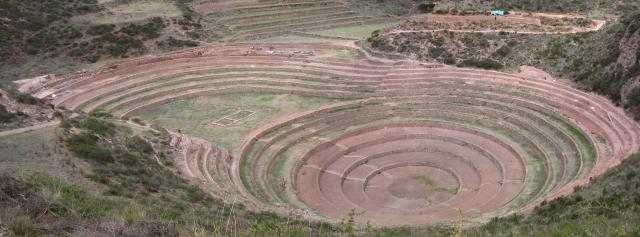
The different levels of terracing each have their own microclimate which the Andeans used to their advantage. They were thought to have used Moray as an area for testing the optimal growing conditions for their crops. With this information the Andeans could determine which areas were best for growing crops and ultimately where they should settle.
Our next stop today is a salt field called Salinas. This is a 5,000+ pool salt mine that is fed from mountain hot springs. Count all the small white dots in the picture below:

Maybe a close up picture will serve us better:
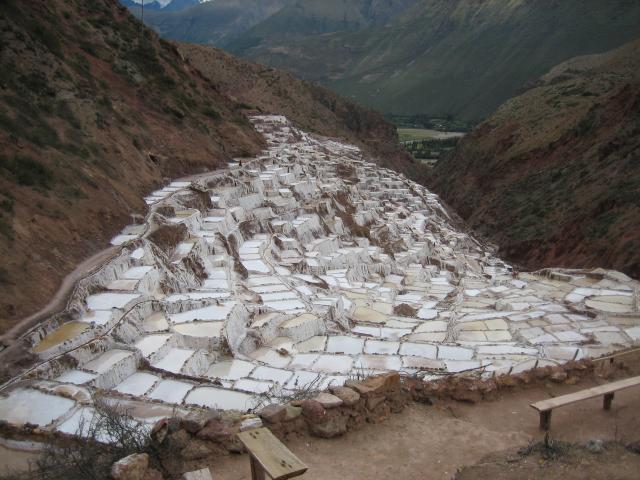
So my understanding of the salt mine is this: each of the 5,000+ pools of salt water, fed from the hot springs in the mountain, can yield 150 kilos (330 pounds) of salt per month. As the water evaporates the salt crystallizes and is harvested. So there’s a lot of evaporation going on and little labor. Sounds like a great job to me—lot’s of TV watching and dipping chips into the salt water to test for consistency.
November 23, 2006
Machu Picchu
When you think of Peru, you think of Machu Picchu. Or you think of the cartoon movie, “Emperor’s Groove” that featured a llama called, “Cusco,” which, as you know by now, is the capital of Peru. Either way, Cusco is involved, as are llamas, regardless if they’re named, “Cusco” or not. And popcorn—I just put that in there because I like popcorn.
Actually I don’t like popcorn because the little things stick between my teeth. I’m a flosser, which means that I floss once a day, and I don’t like to floss more than that, so I stay away from popcorn.
Either way, Machu Picchu is THE place to go when visiting Peru, and the Peruvians have this down to a well-practiced science. There aren’t that many touring companies in Cusco and you have to go through Cusco to get to Machu Picchu.
Before I explain our trip there I should explain what Machu Picchu is.
Machu Picchu is a city that was built around the mid 1400’s. When you think of the ancient Andeans, think 15th century. When you think of the Andeans, think incredible stonework, hardiness of character, and the invasion of the Spaniards. Spain never made it to Machu Picchu, but they were jonesing for them. They probably didn’t make it there because they needed a bunch of oxygen tanks and/or cars, neither of which were invented yet.
Machu Picchu is a small city built on the side of a mountain that was fairly self-sufficient (the Incans were self-sufficient, not the mountain. I sometimes get confused with dangling participles)—they had terraced land that allowed planting and great irrigation; flat lands that allowed herds of animals, and it was the a place of solace and safety for THE INCA, which we know is the one and only head of the Incan empire. This place was built as a retreat or sanctuary for the, “royalty” of the Incas; the idea was that to get here was extremely difficult so attacking here was extremely difficult.
Modern day: getting to Machu Picchu is an adventure itself. There are only two ways to get here: you either hike (very bad idea in my opinion) or you take a train. We opted for the train for several reasons: we have two small children, we’re rational, and we want to live.
When we arrived at the train station we were greeted by authentically-dressed train porters:
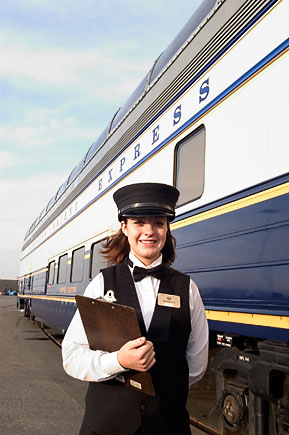
To be honest, this isn’t a picture that we took because we didn’t take any pictures of the train porters. But if we HAD taken pictures of the porters, the picture would have shown someone dressed like this. And I love it. It’s professional, it’s traditional, touristy. It applies to the tourist’s dream of train travel and I loved it.
The train was on time. And it was clean, and efficient. Apparently these guys have done this before, like once a day for about forever.
The train has to go over the Cusco mountain and then down the same mountain. If you’ve followed our travels so far, you know that there are two ways to go up a mountain in a train:
- Funicular—look at our South Africa/Cape Town entry to get information on this
- Switchbacks—OK, I lied. Even if you’ve followed our travels to date, you’ve never heard of us taking a train with switchbacks. But I thought it would be fun to put something silly in the story.
Switchbacks are a clever way to get an ordinary train up a mountain. Actually, we did this in New Zealand, but at a smaller scale. Think of a train going upwards around a mountain at a slight slope, maybe 4-8 degrees. Then the track ends and the train must to go backwards at the same upward slope for a while. Then the track ends and the train must reverse its direction once again.
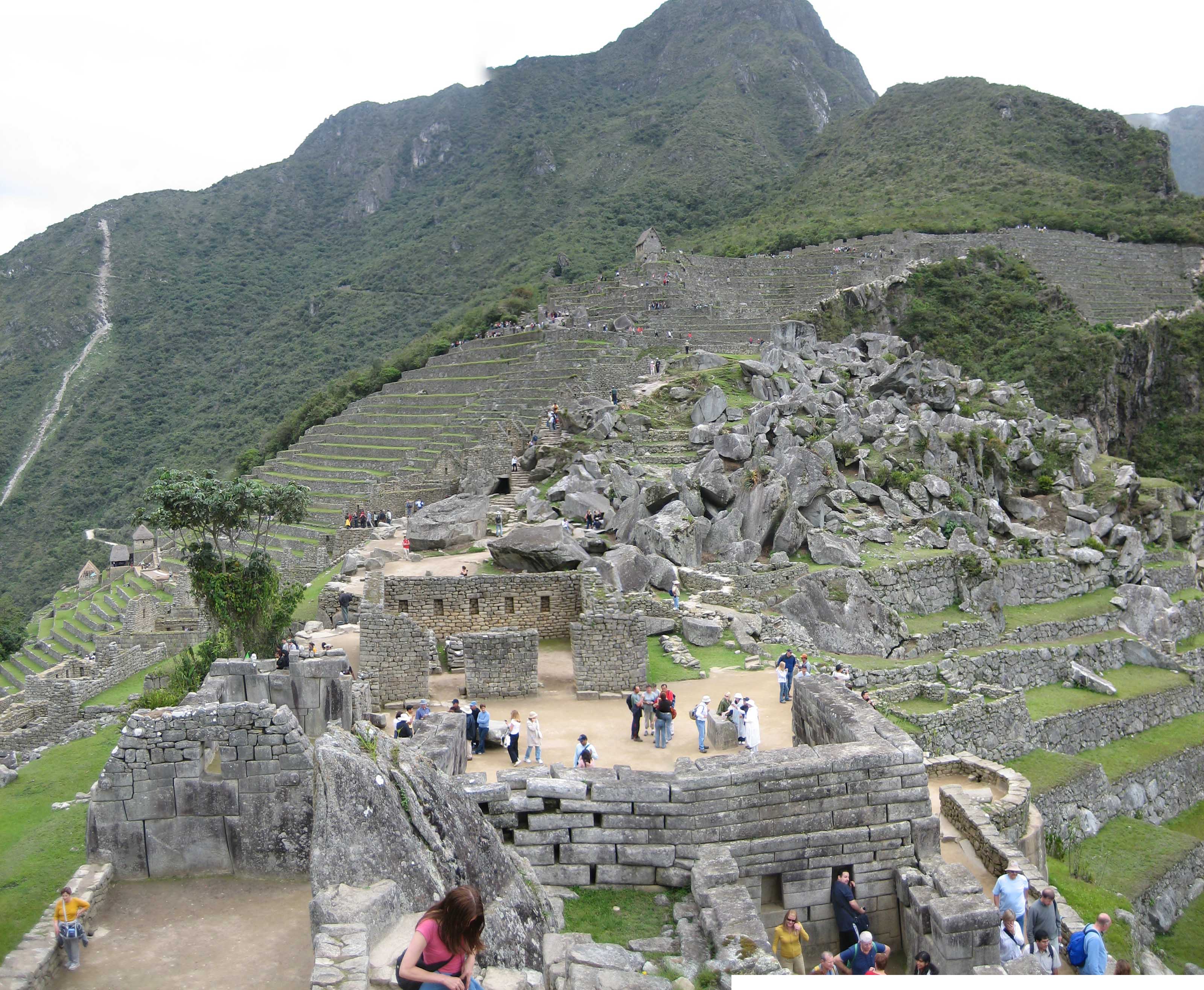
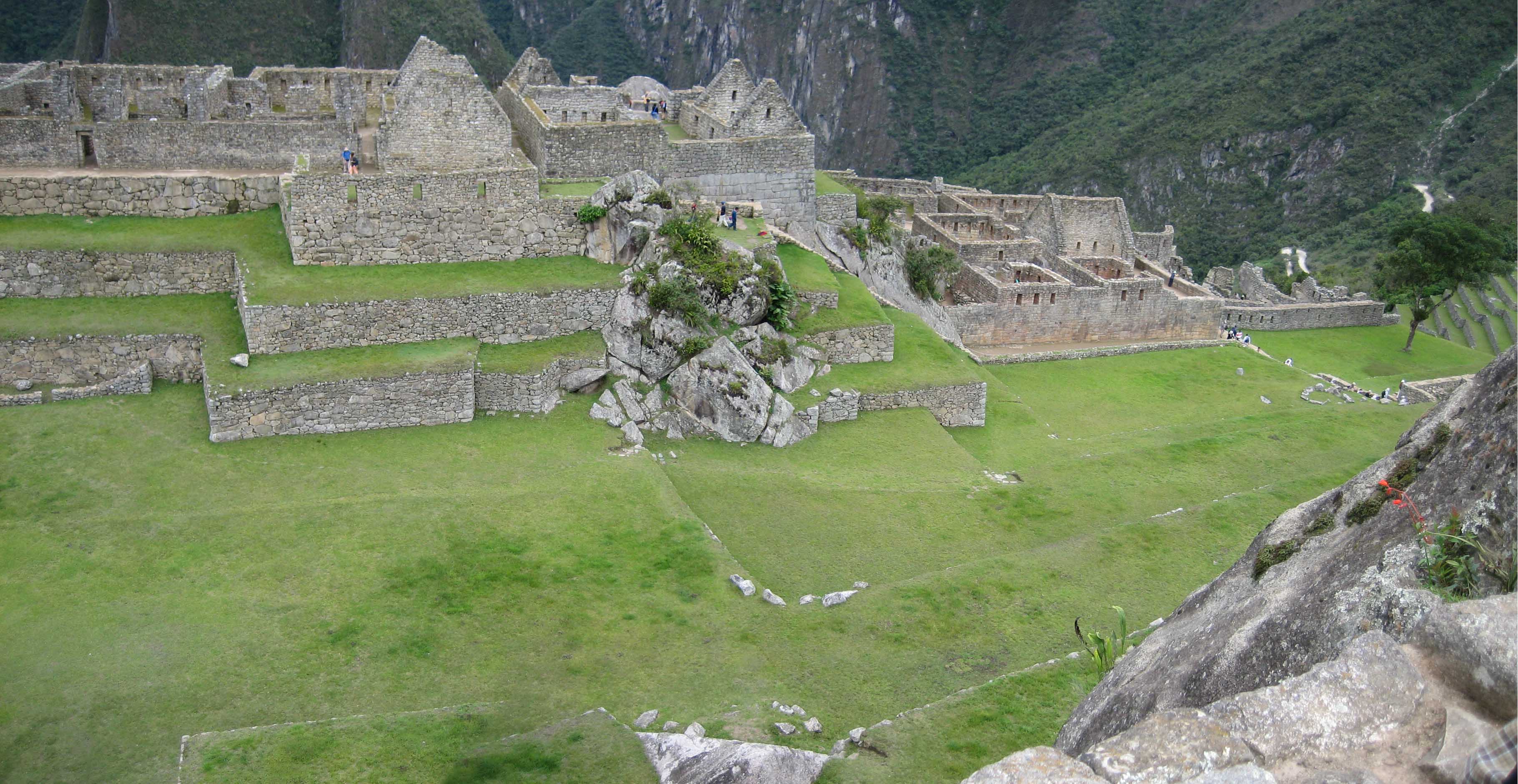
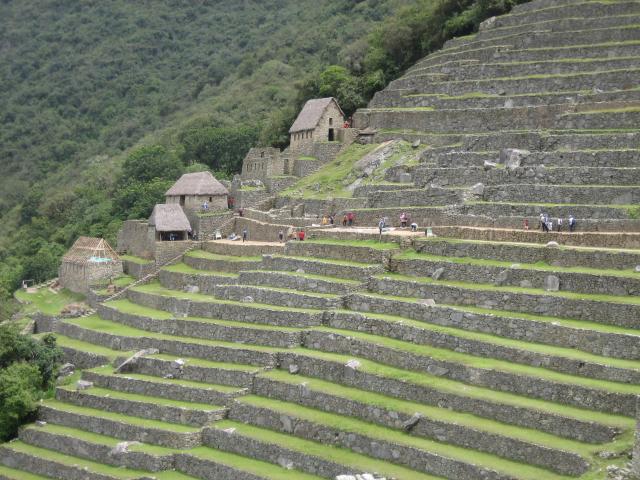
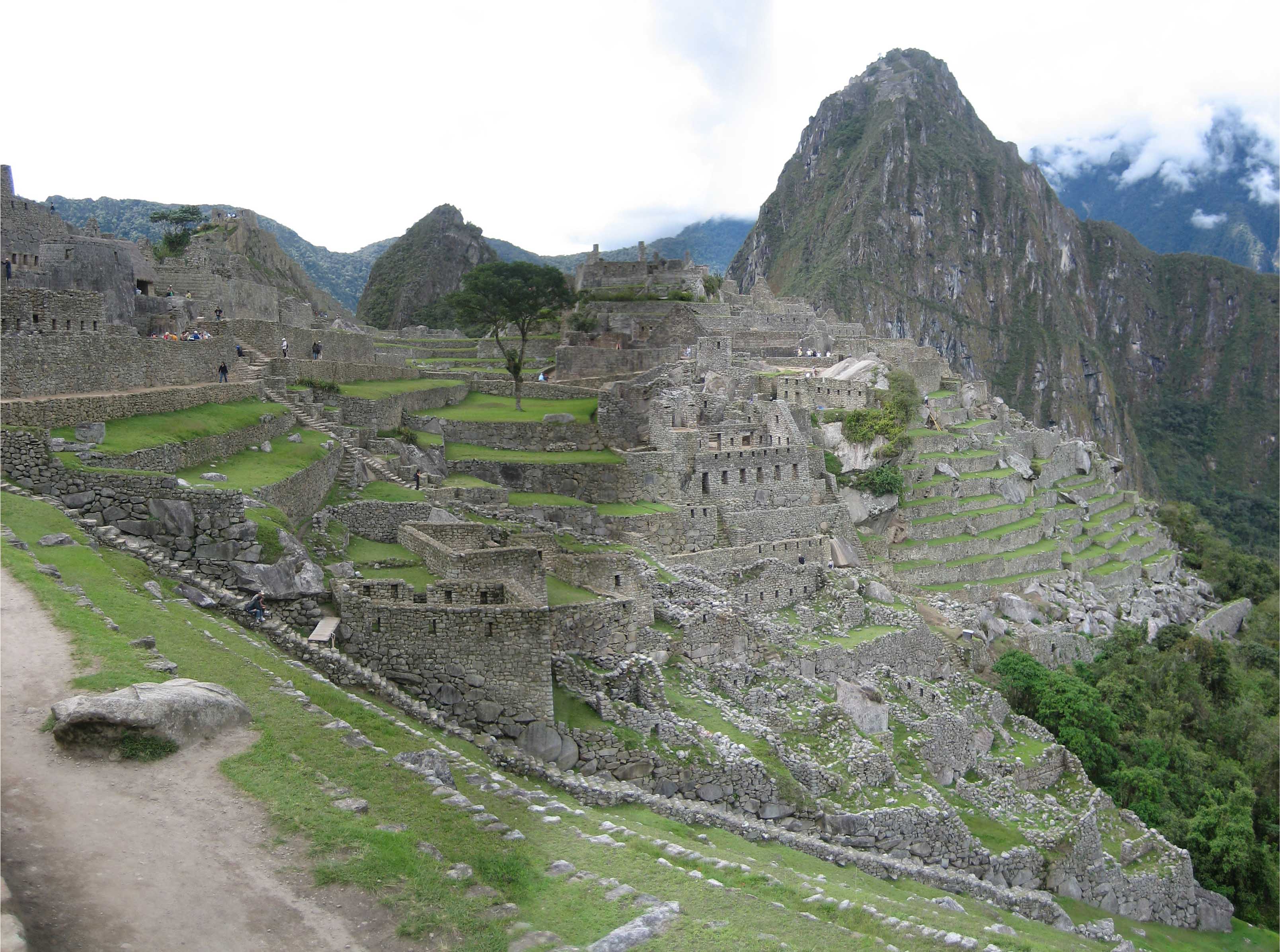
So Machu Picchu is this extremely bizarre place that’s built on the side of a mountain to protect The Inca. It’s the latter day version of US Secret Emergency Relocation Emergency Center. Except back in the 15th century the Incas probably didn’t advertise where The Inca would go in case of emergency, nor would they publish this information on the Internet…
November 24, 2006
Up to this point in our travels, Nicky and I have been extraordinarily clever in many ways. We got free tours at the rubber farm in Thailand; we experienced cockpit time during our flight from Mauritius to Australia; we ate more strange meat than you can count on your fingers and toes; in Chile and Argentina we were able to navigate this strange language called, “Spanish”; we were able to breath the low-oxygen air in Peru. We have done all these things with 4 and 6 year old girls.
What we haven’t been able to conquer are the inane travel schedules of certain airlines, buses and trains. The only train to Machu Picchu (emphasize the singular) leaves Cusco at 6am and arrives at Machu Picchu at 9:15am. There’s only one train that leaves Machu Picchu at 3pm, so either you allow yourself a bit less than 6 hours to tour Machu Picchu, or you do an overnight stay, which is what we did. But an overnight stay is a bit much because we had two small kids and Machu Picchu is the parents’ playground from hell because of the wall and steep hills and the poor timing of the trains.
So we killed about 6 hours walking around a very small town called Aquas Calientes (means Hot Water), the small gatekeeper town that’s close to Machu Picchu, about a 15 min. away by bus. This town is tiny, it’s touristy, and it’s tiny. Did I mention that it’s small? And it was raining and we killed about 5 hours going in/out of the tourist places. And we took a very slow lunch. Then we had another 3.5 hour train ride back.
Ouch. No beverage car on this train…
November 25, 2006
Today was a day in Cusco. We walked downtown and saw one of Cusco’s two stoplights:
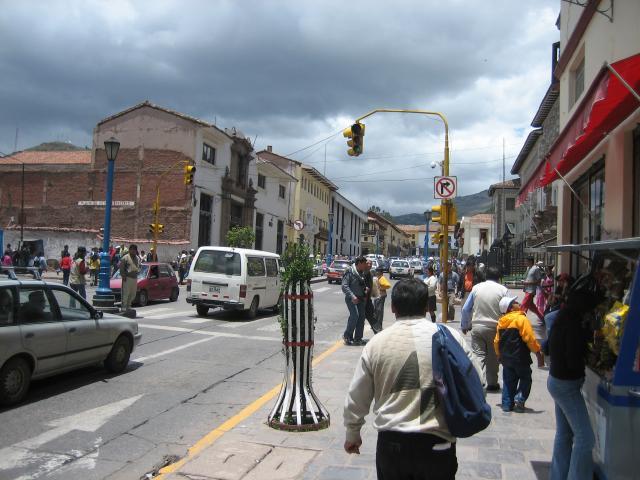
Seriously, there are very few traffic lights and signs. I really counted two traffic lights. There’s very little traffic in Cusco because the majority of people that live there don’t own cars. All the traffic is tourist-related buses and taxis.
During our town tour we visited an art place that funded native weaving. They brought the weaved textiles from the local communities and sold them abroad or locally. On the weekends they featured the local artists doing their crafts.
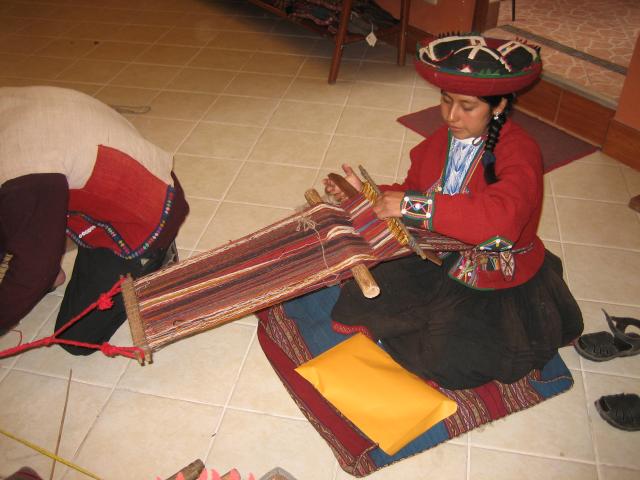
The local way to do wraps/cloths is to hook your, “loom” to a central post and do your weaving by hand, and many of the other locals use the same post as their anchor for their weave.
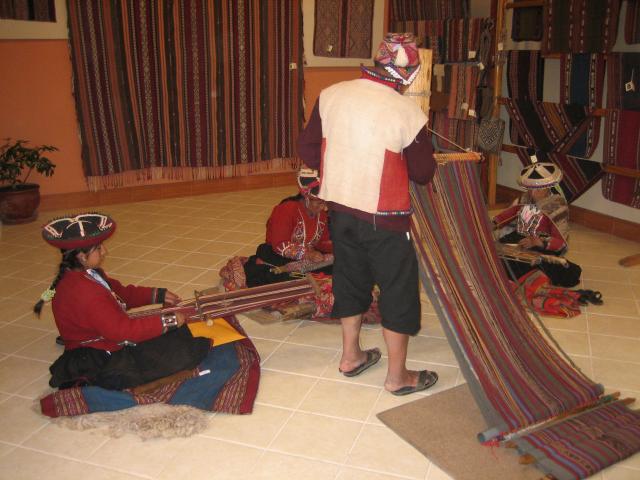
After our sojourn to the Cusco municipal center, we took a nap and went to the central park. Again, if you have not been following our travels to date, the South American definition of parks or central parks are wonderful grassy areas that encourage people to gather. The central park in Cusco is no different—they have a wonderful fountain and the park is framed by a very old church and a wonderfully quaint shopping center.
Today I took my banjo to the park to practice, as I’ve done in many different countries, and as I’ve done here a couple times past. This time I had my wife and two children, but they didn’t scare me from playing because they know how badly I play.
When we entered the park today we noticed a one-eyed beggar on the sidewalk against the wall. Of course the kids can’t resist looking, nor can they resist yelling things like, “Mommy, that guy has only one eye!” Normally, this could be funny in an alternate universe that makes fun of our less-fortunate people; on this planet it’s a difficult sell. But Annette, our precocious 4 year old, continued to stare and say things like, “Mommy, why does he have one eye?”, “What happened to his other eye?”
This got Nicky and me to thinking of eye jokes, like, “I’ve got my eye on you” and,
Nicky: Hey, get your hands off my butt!
One-eye-guy: I’m sorry, I was just looking…
But I digress; my children and my wife and I were going to spend a wonderful afternoon in the main square in Cusco. And the weather was wonderful, and the fountain was flowing, and there was a wonderful musical group by the fountain when we arrived. I had my banjo on my back and we found a free bench near the musicians so we could both enjoy the day, our surroundings and their music.
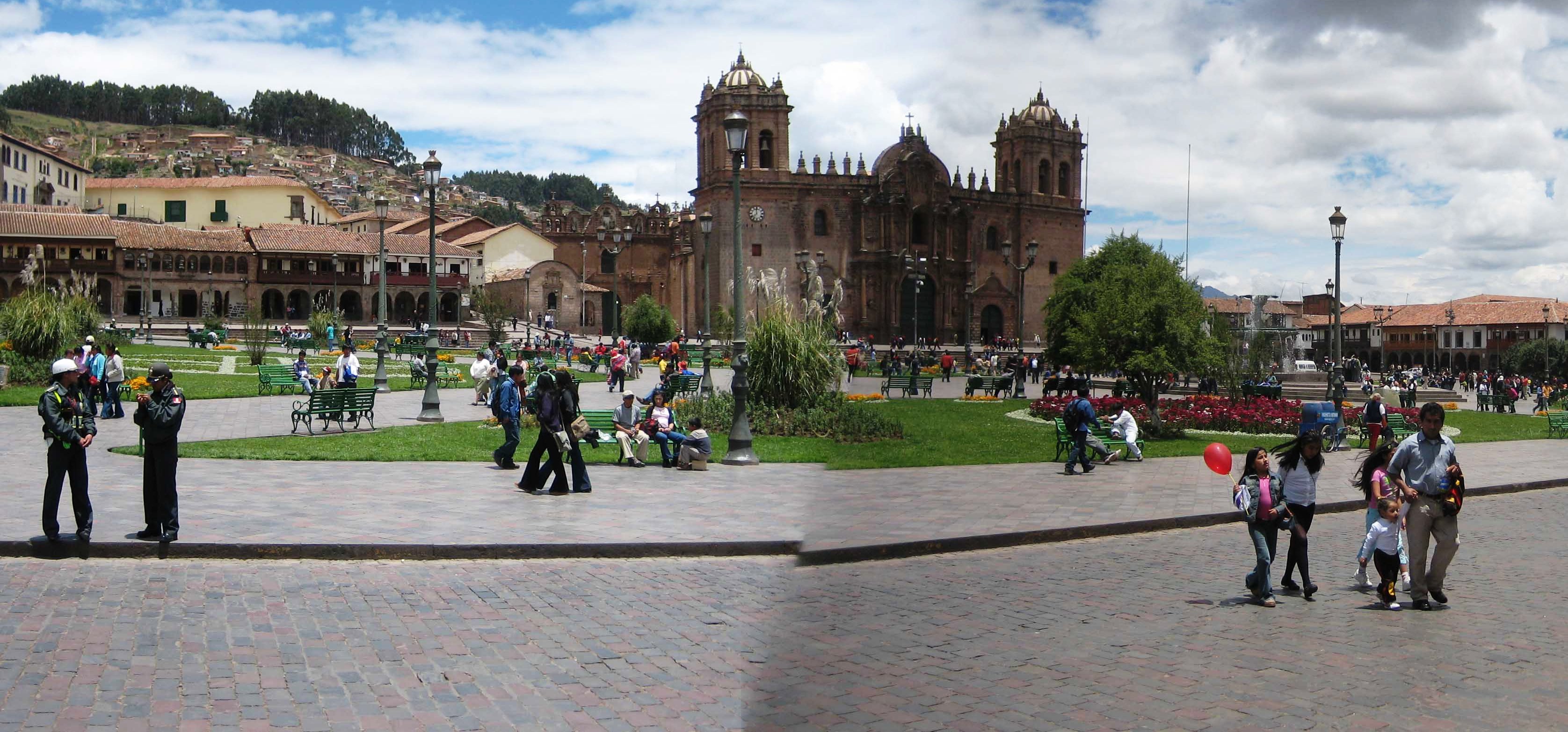
We were able to enjoy the day for about 12 minutes. Apparently these musicians were at the end of their set and they started walking around the fountain. They spotted me and my banjo and all four of them approached. Here’s what I remember of the conversation:
Them: Hello, is that a banjo that you have?
Me: (Man, I’m in trouble. These guys are in uniform, they’re wearing capes and pantaloons!! Capes and Pantaloons!! They’re really good and they’re in uniform. I’ve been practicing at parks all throughout Thailand, South Africa, Australia, New Zealand and Chile and to date I’ve been able to fake my banjo skills. And I’m not in uniform. Nor do I wear a cape. I don’t even own pantaloons.) Yes, this is a banjo.
Them: That’s great! Can you play something for us? (They speak English and they wear capes. I’m just waiting for a crime to be committed and they all fly away, or see something with their x-ray vision. There’s no way I can play with these guys).
Me: Sure, give me a minute to tune. (There are four musicians here and about 30-50 people following them, all huddling around my bench. And they’re wearing capes and pantaloons. Capes!)
It’s a bit chilly here and my fingers are a little cold, so as I extract my banjo from its case I’m concerned about the following:
- Their high expectations about my banjo playing ability. These are (I think) professional musicians (they could be superheroes in disguise—they’re wearing capes after all…) and they know about the banjo and I think their expectations are high. And I’m also very nervous and my kids and wife are here and after a bit of over-thinking I’m a bit concerned that they might be super villains instead of superheroes.
- My fingers are cold—cold fingers don’t move well; they don’t play well on the banjo.
- My wife is recording this. Not good for many varied reasons.
- We have an audience of about 30-50 people here (did I mention that before?). Some are Americans; It’s more difficult to fool Americans. This is getting worse and worse… Perhaps a caped crusader will come here and foil the evil musicians plan…
Me: (Trying to by time) please play something for all of us while I tune (this means that I want to practice my rolls in the background to get warmed up).
Them: (they play a really great tune—just listen):
Video: Park Performers
Note: if you can not see the video, download QuickTime and view the movie with it.

Them: Please play something for us.
Me: Love to. (I play a couple well-known banjo tunes and I don’t do badly. Nicky didn’t record these, which is probably a good thing, but I didn’t embarrass myself. I tried to get them to play backup with me by telling them the chord progression, and we got something that sounded pretty good).
Then we tried to jam/play together on some of their tunes and some that I knew. I think that their tunes are some 3/16 timing with B7-minor diminished predicate-perfect chords (is there such a chord?) that I have no idea how to even get close. Hey, I play bluegrass banjo that consists mostly of G, C and D chords in 4/4 time. Anything outside of that and I’m just a bystander.
After their great playing and my attempts to hang with them, we were able to talk about each of our backgrounds. These guys are college students majoring in music from all across South America. They all belong to a musical club/group/fraternity that tries to share music with others. These four cape-wearing, pantaloon-donning, college students are traveling Peru and Argentina for the next 3 weeks to share their love of music. I don’t know where they got the money, but I applaud their effort and their accomplishment.
And I learned that they shy away from Kryptonite for some reason…
November 25, 2006
(Sigh) We went on yet another tour today. Verily, this be correct. I’m not sure how we got roped into the tour scene, but today we were bus-people. The guide was good enough, and the stuff we saw was OK, but everything was very touristy. On schedule today was a bazaar and some architectural thing which was never thoroughly explained to me, nor ever understood by me. It just had a lot of steps. But I digress—here’s a rundown of our day:
Take a look at this picture of an “authentic” Peruvian church with the church’s servants standing in front of the doors ready to collect the parishioner’s donations.
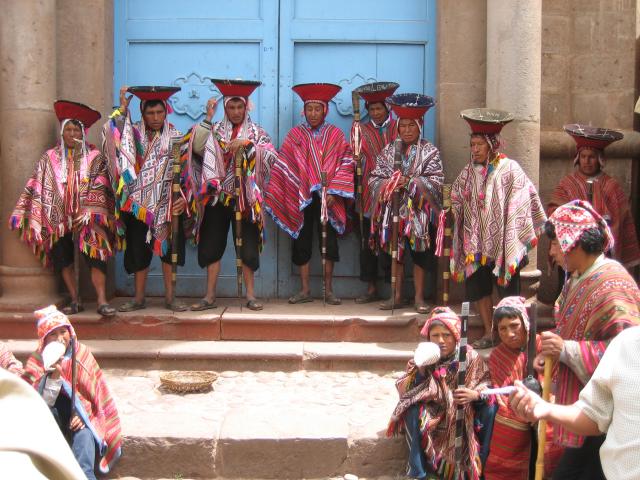
Not only is it too posed, it’s too polished. C’mon—who goes to work with a plate strapped to their head?,,,
The bus took us to an authentic Peruvian market that features authentic Peruvian wares. I was skeptical about the authenticity of the Peruvian wares, and my skepticalness (is this a word?) was verified when I saw the following:
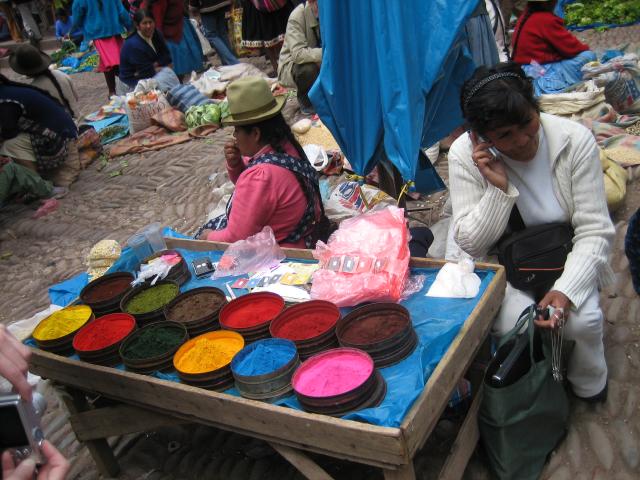
This vendor was described to me as authentic Peruvian corn-based, hand-ground dyed powders. It’s hard to envision the hand-grinding when the dude that’s selling it is talking on a mobile phone.
Plus the dude 7 stalls down is selling the exact same stuff.
They don’t cut the nose off of the beef:
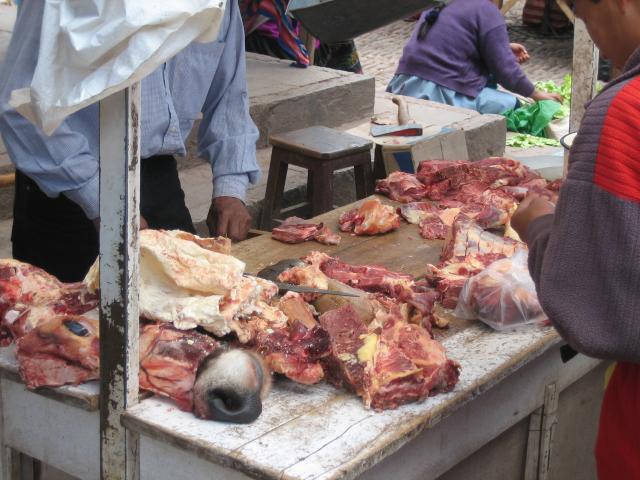
That’s tough for us Americans to get used to. That, and the 80+ heat and they don’t’ refrigerate the meat…
We saw some cool old ladies doing some cool manual weaving:
Video: Lady Weaving
After the bizarre bazaar, we visited another feat of architectural marvel. The ancient Peruvians (i.e. Incans, but apparently you can’t call them that because THE INCA is the only one that’s INCAN) knew how to work stone. And they had to know about terracing because they continued to build things on the side of the mountain.
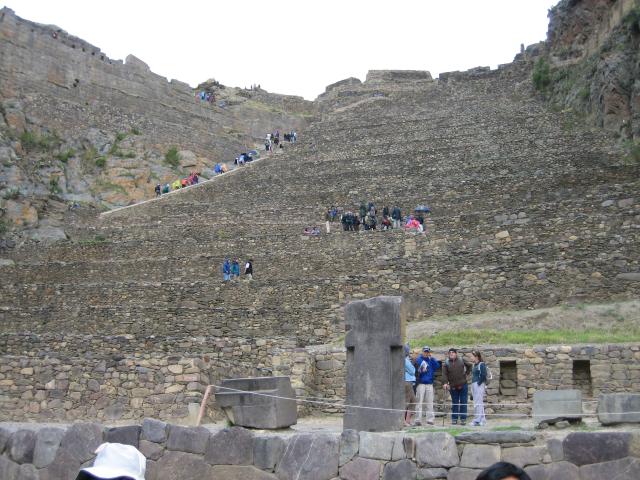
If you want to play horseshoes on the side of a mountain, then you have to terrace the mountain. Flat spaces are needed and enjoyed. If you’re a cow and you live on the side of a mountain and you have a baby, then you need strong calves.
Yes, I, too, groan and bemoan the really bad pun. This is the worst of jokes, the mountain notwithstanding. I have friends that think it’s great. They are wrong.
|